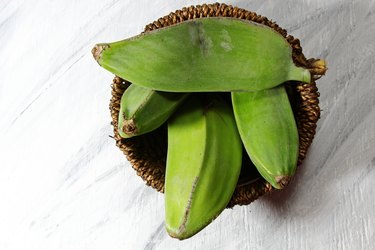
If you eat bananas, you probably have strong feelings about which level of ripeness you prefer. Some like the faintly acidic tang of a banana that's still a bit green, while others prefer the lush sweetness of a fully ripened banana that's turning brown. With plantains, or cooking bananas, the situation is rather different. Picking plantains is less about whether they can be used than it is about how you plan to use them.
Plantains vs. Bananas
Video of the Day
Bananas and plantains form a large family, with hundreds of closely related subspecies. Botanically, they're nearly identical, so the distinction is a practical rather than a scientific one. If the fruit remains high in indigestible starches as it ripens, it's considered a plantain and must be cooked. If its starches convert almost entirely to sugars as it ripens, it's a banana and is typically eaten raw. This isn't a hard and fast rule — sweet bananas can also be prepared as a starchy vegetable when they're green and immature — but it's a good rule of thumb.
Video of the Day
Green and Yellow Plantains
Most of the plantains you'll see at the market are unripe or under-ripe specimens, with a green or yellow skin. This is the starchiest and most vegetable-like stage of the plantains' ripening process, and, unsurprisingly, they're used as a starchy vegetable. Green plantains are the ones used for plantain chips, or for twice-fried tostones. They're also diced and used as a vegetable in soups or stews, just as carrots and potatoes are in more northerly climes.
Slightly riper plantains, with yellow skins, are a bit sweeter — think sweet potato versus potato — and are typically baked or boiled first, and then mashed. Green and yellow plantains can be hard to peel, so slash their skins and soak them first for a minute or two in very hot water to soften the skin.
Ripe Plantains
Sweet bananas are soft and mushy by the time their skin turns black, but that's not the case with plantains. A fully black skin, or one with only a few fugitive traces of yellow, is the sign of a plantain that's fully ripened. You usually won't find them that ripe at the store, so you'll need to buy green or yellow plantains and keep them in a paper bag until they've ripened.
The skin is easier to remove at this stage, and the fruit underneath is sticky and mushy at the surface but still firm enough in the middle to hold its shape. At this stage, they're usually fried slowly until the surface is well caramelized and the interior very soft, then served as a sweet side dish — platanos maduros — with savory meals.
Overripe Plantains
If you regularly ripen plantains for platanos maduros, sooner or later you'll leave them to ripen for too long. When the plantain's skin is not just black but wrinkled, and the plantain itself is visibly shrunken and soft to the touch, they're at their peak of sweetness and most banana-like flavor.
Like overripe bananas, this is the time to use them for baking and sweets. The Latin world has many recipes for these last-stage fruits, but you can simply substitute them for ripe bananas in your favorite banana bread, banana cake or banana pudding. They lack the cloying sweetness of overripe bananas; a positive if you ordinarily find banana desserts to be too much for your taste buds.